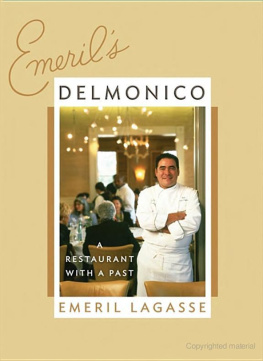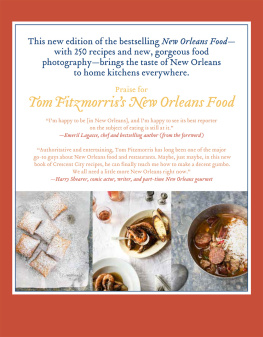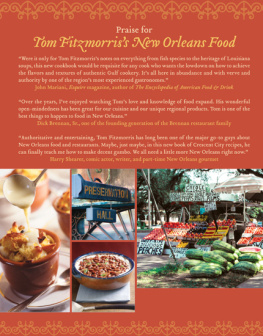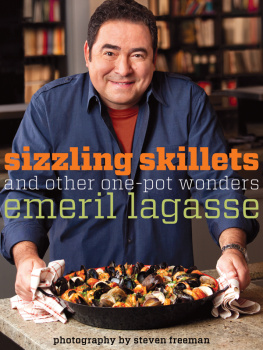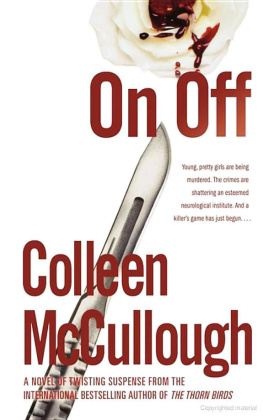For Angie Brown and Rose Dietrich, two gracious ladies, who not only gave me the opportunity to take their beloved restaurant into a new era but also inspired me to continue the traditions that generations of New Orleanians hold in such high esteem.
It was with great honor that I accepted the challenge of carrying on the torch to continue to maintain the high standards of attention to food, wine, and personal service that is so essential for the success of a great restaurant. I hope that I have made the ladies proud.
I would like to take the opportunity to pay tribute to the old Delmonico cooks, the unsung heroes as far as Im concerned, who were the backbone of the kitchen staff for many, many years. Here is my personal salute to Ernest Jitterbug Rome, Elmer Decquir, Irene Polk, Atwood Davis, and the late Kennis Leonard. Long before chefs were visible in the front of the house, the cooks in earlier times labored long and hard in the back of the house without much fanfare or accolades. A tip of my toque to all of you!
I also want to salute the longtime waiters and waitresses of old Delmonico who were always diligent in taking care of the generations of customers who frequented the establishment.
I n 1895 New Orleans recorded eight inches of snow on Valentines Day. In the same year Charles Buddy Bolden, who some believe gave birth to improvised music that later became known as jazz, was at the peak of his career. The third Hotel St. Charles, designed by architect Thomas Sully, was completed. The Hennen Building, at the corner of Common and Carondelet, was finished, and at ten stories high, became the citys first skyscraper. The Dr. Tichenor Antiseptic Waltz was written by Louis Blake and published by the Sherrouse Medicine Company, Ltd., based in New Orleans.
It was also in the year 1895 that Delmonico opened its doors at the corner of St. Charles Avenue and Erato Street in what is now the Lower Garden District. Seventy years after the original Delmonicos, of New York opened, Anthony Commander, who owned a saloon on Magazine Street in New Orleans, was able to obtain the blessings of the New York family to open an independent branch of the renowned New York City establishment in the Crescent City. It was destined to become one of the most popular and best-loved restaurants in the city, especially by local residents.
The Delmonicos Restaurant in New York, which began in 1827 as a small caf and pastry shop at 23 William Street in what is now the Financial District in lower Manhattan, expanded next door and by March 1830 had the distinction of becoming the first restaurant or public dining room to open in the United States. Their policy from the very beginning was to serve the finest quality foods in an impeccable manner. The Great Fire of 1835 destroyed much of lower Manhattan, including the restaurant on William Street, so the brothers set about remodeling part of the lodging house to accommodate the restaurant while they began construction nearby for a new building to house their restaurant, which opened in 1836. The three-and-a-half story construction featured inlaid floors and grand dining rooms decorated with expensive furnishings. The kitchen was one of the finest in the city and the wine cellar held sixteen thousand bottles of wine.
The restaurant was always on the cutting edge, serving an extensive menu of 370 items, and celebrities from around the world found their way to this magnificent establishment. Many classics of American cuisine are said to have originated at Delmonicos during the tenure of chef Charles Ranhofer, including lobster Newburg, Chicken la King (Poultry: Masters of the Game), eggs benedict, and Baked Alaska (Sweet Success).
It enjoyed grand times and great success, but the continuing escalation of food costs, the deaths of family members that led to changes in ownership and managers, as well as battles between siblings and owners, and then the final blowProhibitionbrought the business to its knees. On May 21, 1923, a final dinner was held, and just less than a century since the first Delmonicos Restaurant was opened in New York, the institution died. (Note: Neither the current Delmonicos Restaurant at Beaver and South William streets nor the Delmonico Hotel on Park Avenue has any connection with the Delmonico family or the original business.)
But the independent Delmonico in New Orleans lived on and thrived.
Not much is known about Anthony Commander. We do know that he was the youngest brother of Emile Commander, who opened a saloon that he dubbed Commanders Palace in 1880 on the corner of Washington Avenue and Coliseum Street in the Garden District in New Orleans. The establishment is now the famed Commanders Palace, owned and operated by the Brennan family.
A third brother, Charles J., was a prominent businessman, who with Emile and their grandfather Peter owned a grocery business, a broom factory, and at one time had a commercial orange grove in Metairie, a suburb of New Orleans.
We also know that Mr. Commander opened the New Orleans Delmonico in a building built in 1890 as a one-story dairy creamery that later gained a second story by 1911. The top floor served as a gymnasium where gentlemen in bow ties boxed to work off some of the luncheon specials. (Photographs of this era grace the walls of the elegant bar at Emerils Delmonico today.)
The menu under Mr. Commanders ownership reflected his association with Delmonicos in New York, featuring steaks and French-style dishes, but also included classic New Orleansstyle dishes.
The restaurant became a favorite dining spot for local businessmen who had offices in the neighborhood, but because of some personal business problems, Mr. Commander handed the torch of ownership to Anthony LaFranca in 1911.
LaFranca, at age twelve, came from Sicily to New Orleans where he began working at Tranchinas Restaurant on Carondelet Street and Howard Avenue. It was there that LaFranca met his bride, Marie Masset. Her grandfather was the proprietor of the restaurant. With the help from the Eureka Homestead Society and a short-lived partnership with Joseph Smurchich, who lived on Euterpe Street behind the restaurant, LaFranca purchased Delmonico.
When LaFranca began active management of the restaurant, the two-door entrance to the ornate Edwardian building was highlighted by the words Restaurant Caf. A corner lamppost of three globular lights stood at the entrance at Erato and St. Charles. The windows and fanlights over the entrance were of leaded glass and the floors were of an intricate tile design in the pattern of an Oriental carpet, which created an elegant atmosphere.

